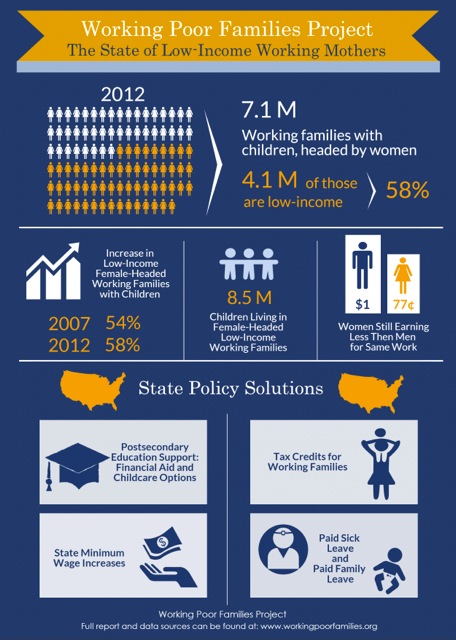The “working poor” are people who spend 27 weeks or more in a year in the labor force either working or looking for work but whose incomes fall below the poverty level. According to the U.S. Bureau of Labor Statistics, about 9.5 million of people who spent at least 27 weeks in the labor force were poor. That year, the working poor comprised 6.3 percent of all individuals in the labor force.
Low-Income is defined as a family income below 200% of poverty. In 2015, the poverty threshold was $24,250 for a family of four. A quarter of those receiving food stamps live in households where at least one person works 30 or more hours a week, according to the University of California Berkeley Center for Labor Research and Education Research.
- 1 in 3 working US families struggle to meet basic needs.
- There are 10.6 million low income working families in the US.
- More than 48 million people (23.9 of which are children) live in low-income working families.
- There are 4.1 million low income working families with children headed by working mothers.
- Almost half of working mothers who are low-income are employed in retail and service sector jobs that often pay low-wages, limit hours and fail to provide benefits such as health and paid sick leave.
The rise of female-headed families in the United States has been one of the major social trends of the past 50 years. The majority of female-headed families work, but they are disproportionately burdened by poverty, compared with two-parent families. The latest data from the Census Bureau show that female-headed working families make up 22% of all working families, but they make up 39% of low-income working families. A single mother with three children would need to work full time, year round for $22.80 an hour to no longer be considered “low income.”
Parents need financial resources as well as human and social capital (basic life skills, education, social networks) to provide the experiences, resources, and services that are essential for children to thrive and to grow. The negative effects of working poor families on children, especially young children, are cause for concern. Research has found low income children, even those that were temporarily low income have associated difficulties later in life — dropping out of school, poor adolescent and adult health, and poor employment outcomes. Stable, nurturing, and enriching environments in the early years help create a sturdy foundation for later school achievement, economic productivity, and responsible citizenship.

